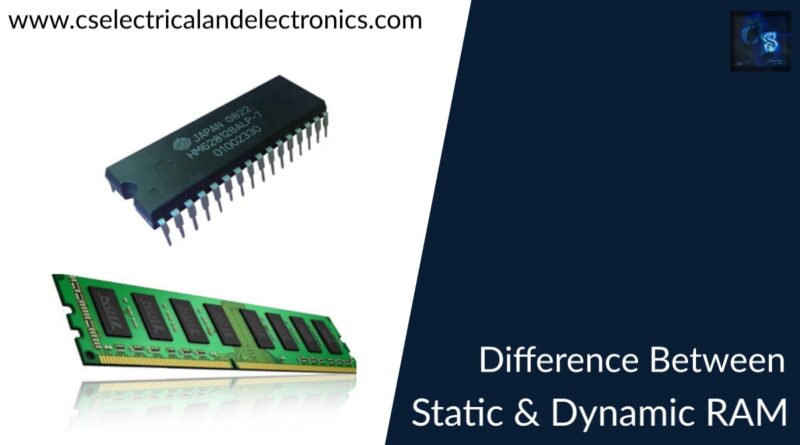Difference Between Static RAM And Dynamic RAM, Applications
Hello guys, welcome back to our blog. In this article, we will discuss the difference between static RAM and Dynamic RAM, what is static RAM, what is dynamic RAM, and the applications of both RAMs.
If you have any electrical, electronics, and computer science doubts, then ask questions. You can also catch us on Instagram – CS Electrical & Electronics.
Also, read:
- Difference Between Analog And Digital Integrated Circuits.
- Texas Instruments Hiring And Internship Process, Package, Questions.
- Types Of Memories Used In Embedded Systems, Definition, Applications.
Static RAM And Dynamic RAM
Almost all digital systems require memories that can store as well as retrieve data. Random access memory is a type of memory that has both read and write capabilities. The term random access memory means that any storage location in the memory can be accessed in any order to read and write the data. RAM is a read/write random access memory.
RAMs are volatile memories so data are lost if the power is removed. Hence they are used for the temporary storage of data. The applications of RAM are.
- Calculators
- Buffer memories
- Cache memories
- Microcomputer user computer
The bipolar Ram is all static RAM i.e., storage elements used in the memory are latches so data can be stored for an indefinite period of time as long as power is ON.
Dynamic Ram uses capacitors as storage elements to store data and cannot retain data for very long so they have to be periodically recharged by a process called refreshing.
Both SRAM and DRAM will lose stored data when dc power is removed and therefore are classified as volatile memories. Data can be read much faster from SRAM than from DRAM. But DRAMs can store more data than SRAM for a given physical size and cost because DRAM cells are much simpler than SRAM.
Difference Between Static RAM And Dynamic RAM
| SI.No | Static RAM (SRAM) | Dynamic RAM (DRAM) |
| 01 | Contains fewer memory cells per unit area (low density) (lesser storage capacity). | More memory cells or compared to static RAM per unit area (high density) (Higher storage capacity). |
| 02 | Access time is less and hence faster memories. (higher speed of operation). | Access time is greater than static RAM. (Lower speed of operation). |
| 03 | SRAM is manufactured with either bipolar or MOS technology. Bipolar RAMs are all static RAMs. The storage elements used in the static memory are latches or flip-flops. | DRAM is manufactured using MOS technology. In dynamic memory, information is stored in the form of a charge on a capacitor. |
| 04 | Refreshing circuitry is not essential. | Refreshing circuitry is essential to maintain the charge on the capacitor after every few milliseconds. |
| 05 | The hardware required is less. | Extra hardware is required for refreshing so the design is complicated. |
| 06 | Used as cache memory. | Used as the main memory. |
| 07 | The cost is more. | The cost is less. |
| 08 | Data can be stored for an indefinite period of time as long as the power is on. | Data is stored only for a few milliseconds. |
Static RAM
The basic types of SRAM are:
01. Asynchronous SRAM is one in which the operation is not synchronized with a system clock.
02. Synchronous SRAM with burst feature. The operation of synchronous RAM is synchronized with the system clock.
The burst feature is that which allows the memory to read or write up to four locations using a single address. The two lowest address bits A0, and A1 are applied to the burst logic circuit. SRAMs are used for smaller rapid access memory.
Dynamic RAM
Dynamic memory cells store a data bit in a MOS transistor and small capacitor rather than in a latch. The advantages of dynamic RAM are that the individual cells are simpler than flip-flops requiring less area on chips, having lower power consumption, and low cost per bit.
DRAMs are used for bulk memory. The disadvantage is that they are slower the charge stored in the capacitor cannot hold it for a longer period of time and leaks or loses the stored data bit unless its charge is rewritten into it periodically. This is called refreshing memory. Refresh requires additional memory circuitry and complicates the operation of the DRAM.
The cost of DRAM is less. Hence they are widely used in present-day systems.
This was about “Static RAM And Dynamic RAM“. I hope this article may help you all a lot. Thank you for reading.
Also, read:
- 100 + Electrical Engineering Projects For Students, Engineers
- 1000+ Electronics Projects For Engineers, Diploma, MTech Students
- 1000+ MATLAB Simulink Projects For MTech, Engineering Students
- 500+ Embedded System Projects For Engineer, Diploma, MTech, PhD
- 500+ Projects For Diploma Electrical, Electronics Student, Diploma Project
- 8051 Microcontroller Timers, TCON Register, TMOD Register
- Advancements In 3D Printing Technology And It’s Future
- Advancements In Power Electronics For Energy Efficiency
Author Profile
- Chetu
- Interest's ~ Engineering | Entrepreneurship | Politics | History | Travelling | Content Writing | Technology | Cooking
Latest entries
 All PostsApril 19, 2024What Is Vector CANoe Tool, Why It Is Used In The Automotive Industry
All PostsApril 19, 2024What Is Vector CANoe Tool, Why It Is Used In The Automotive Industry All PostsApril 13, 2024What Is TCM, Transmission Control Module, Working, Purpose,
All PostsApril 13, 2024What Is TCM, Transmission Control Module, Working, Purpose, All PostsApril 12, 2024Top 100 HiL hardware in loop Interview Questions With Answers For Engineers
All PostsApril 12, 2024Top 100 HiL hardware in loop Interview Questions With Answers For Engineers All PostsMarch 22, 2024Driver Monitoring Systems In Vehicles, Working, Driver Sleepy Alert
All PostsMarch 22, 2024Driver Monitoring Systems In Vehicles, Working, Driver Sleepy Alert








